Craving a dish that delivers big flavors with minimal effort? This spicy gochujang noodles recipe is your answer! Featuring creamy gochujang sauce and a medley of fresh veggies, this vegan noodle recipe is an exciting fusion of taste and simplicity. Whether you’re new to Korean cuisine or a longtime fan, this recipe will surely become a staple in your meal rotation.
Why You’ll Love This Spicy Gochujang Noodles Recipe
- Packed with Flavor: The combination of gochujang paste, lime juice, and tahini creates a sauce that’s spicy, creamy, and tangy.
- Customizable: Use your favorite vegetables, noodles, and proteins to make it your own.
- Quick & Easy: Perfect for busy weeknights, this recipe comes together in under 30 minutes.
- Vegan-Friendly: Enjoy a plant-based take on classic Korean spicy noodles.

Ingredients & Substitutions
Main Ingredients For The Gochujang Noodles Recipe
Ramen Noodles or Rice Noodles:
For the best texture and flavor, traditional ramen noodles are a great choice. They are chewy, soft, and soak up the spicy sauce beautifully, creating the perfect base for this dish. However, if you need a gluten-free option, wide rice noodles are a fantastic substitute.
These noodles have a slightly different texture but still provide a satisfying chewiness and work wonderfully with the gochujang sauce. You can also experiment with other types of noodles, such as soba or udon, depending on your preference.
Edamame Beans:
While edamame beans are optional, they’re a fantastic addition to boost the protein content of this vegan dish. These young soybeans have a mild, slightly sweet flavor and a nice crunch that contrasts with the soft noodles. If you can’t find edamame or prefer a different option, snap peas, broccoli florets, or even chickpeas work well as alternatives. If you want more protein, feel free to add cooked tofu, tempeh, or even vegan ground meat. The choice is yours to make!
Green Onions:
Green onions, also known as spring onions, add a fresh, zesty pop of flavor to the dish. Both the white and green parts of the onions are used in this recipe. The whites are sautéed with the vegetables to infuse the dish with a mild onion flavor, while the green tops are used as a garnish to provide a burst of color and extra freshness. If you don’t have green onions, you could substitute them with chives or shallots, though the flavor won’t be quite the same.
Vegetables:
Vegetables are an essential part of this dish, bringing both texture and nutrition. Mushrooms and cabbage are excellent choices, as they absorb the sauce well and add a savory umami depth. Mushrooms, in particular, have a meaty texture that makes them a great addition to plant-based dishes. Cabbage adds crunch and a mild sweetness that balances the spicy sauce.
Other vegetables that work wonderfully in this dish include bell peppers (for sweetness), zucchini (for moisture and mild flavor), and snap peas (for an extra crunch). Feel free to get creative with your vegetable selection depending on what you have on hand or what’s in season.
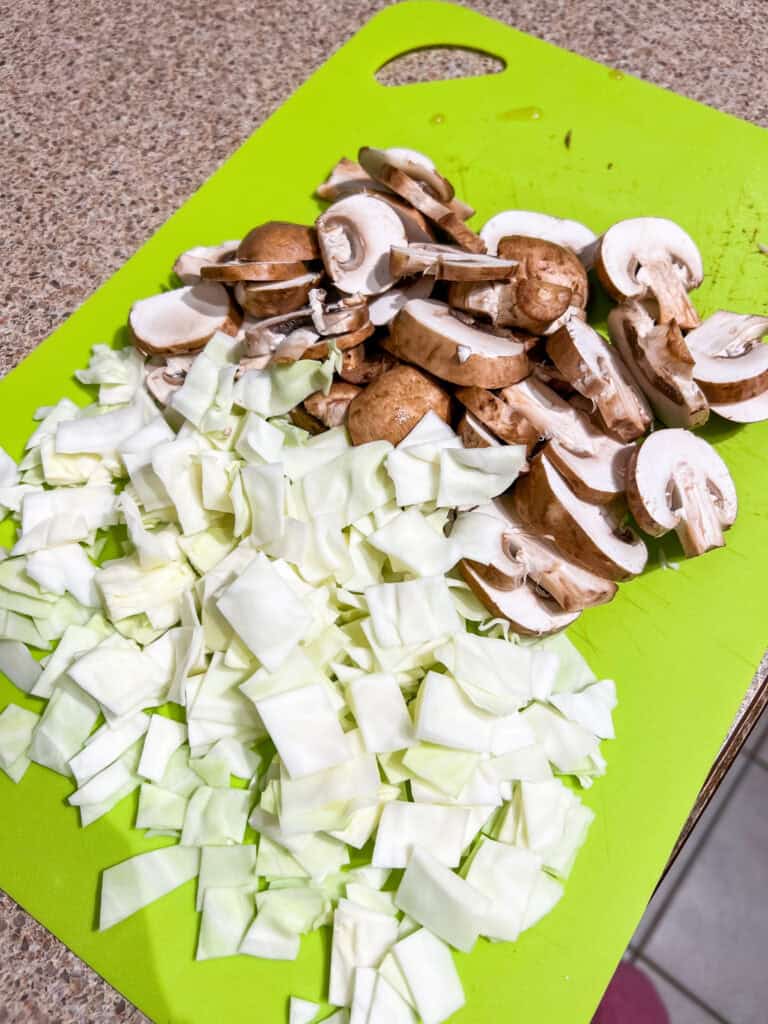
Creamy Gochujang Sauce Ingredients
Gochujang Paste:
The key ingredient in this dish, gochujang is a fermented Korean chili paste made from red chili peppers, glutinous rice, and soybeans. This paste is what gives the dish its bold, spicy, and umami-packed flavor. It’s an essential component of Korean cooking and can often be found in local Asian markets or grocery stores with international food aisles. If you prefer a milder spice level, you can reduce the amount of gochujang paste used or opt for a milder brand. The deep, smoky flavor of the gochujang is what makes these noodles so addictive!
Low-Sodium Soy Sauce:
Soy sauce enhances the savory flavors of the gochujang sauce and adds saltiness to the dish. Using low-sodium soy sauce ensures you control the amount of salt in your meal, making it healthier. If you’re following a gluten-free diet, tamari or coconut aminos are excellent substitutes that provide similar depth without the gluten content. Tamari tends to be a little thicker and richer, while coconut aminos offer a slightly sweeter taste, which can complement the gochujang’s spice beautifully.
Tahini:
Tahini, made from ground sesame seeds, is the ingredient that brings creaminess to the gochujang sauce, balancing out its fiery heat. Its nutty flavor blends seamlessly with the spicy paste, creating a rich, smooth sauce that coats the noodles perfectly. If you don’t have tahini, peanut butter or sesame paste can be substituted, though these alternatives will bring their own unique flavors to the dish. Peanut butter will add a subtle sweetness and a slight peanut flavor, while sesame paste is closer to tahini but with a more pronounced sesame taste.
Lime Juice:
Fresh lime juice is a crucial ingredient to balance the spicy and savory flavors of the gochujang sauce. The tartness of the lime helps cut through the richness of the tahini and adds a refreshing zing to the dish. If you don’t have lime, you can use rice vinegar or white wine vinegar as an alternative. Rice vinegar, commonly used in Korean cooking, will add a slightly sweeter, milder acidity, while white wine vinegar will give a sharper, more tangy kick.
Miso Paste:
Miso paste is optional in this recipe but is a fantastic way to elevate the sauce’s umami depth. This fermented soybean paste adds a savory richness to the dish, complementing the gochujang’s spice. If you don’t have miso paste, you can skip it entirely or replace it with a pinch of salt or soy sauce. For an added depth of flavor, you can experiment with different types of miso, such as white or red, depending on your taste preferences.
Brown Sugar or Maple Syrup:
To balance the heat of the gochujang, a touch of sweetness is essential. Brown sugar or maple syrup is commonly used to add a natural sweetness to the sauce without overpowering the other flavors. Brown sugar contributes a molasses-like richness, while maple syrup gives a slight caramelized sweetness. If you prefer, you can use coconut sugar for a lower glycemic index option, or even agave syrup for a milder sweetness.

Topping Options
- Diced green onions
- Sesame seeds
- Chili oil
Protein Alternatives
Helpful Tools
- Large Skillet: For stir-frying vegetables and combining noodles.
- Whisk: To ensure a smooth sauce.
- Cutting Board and Knife: For chopping vegetables and green onions.
- Colander: To drain the cooked noodles.
How to Make This Gochujang Noodles Recipe
Step-by-Step Instructions
- Boil the Noodles: Follow the package instructions to cook the noodles. Rinse with cold water to prevent sticking.
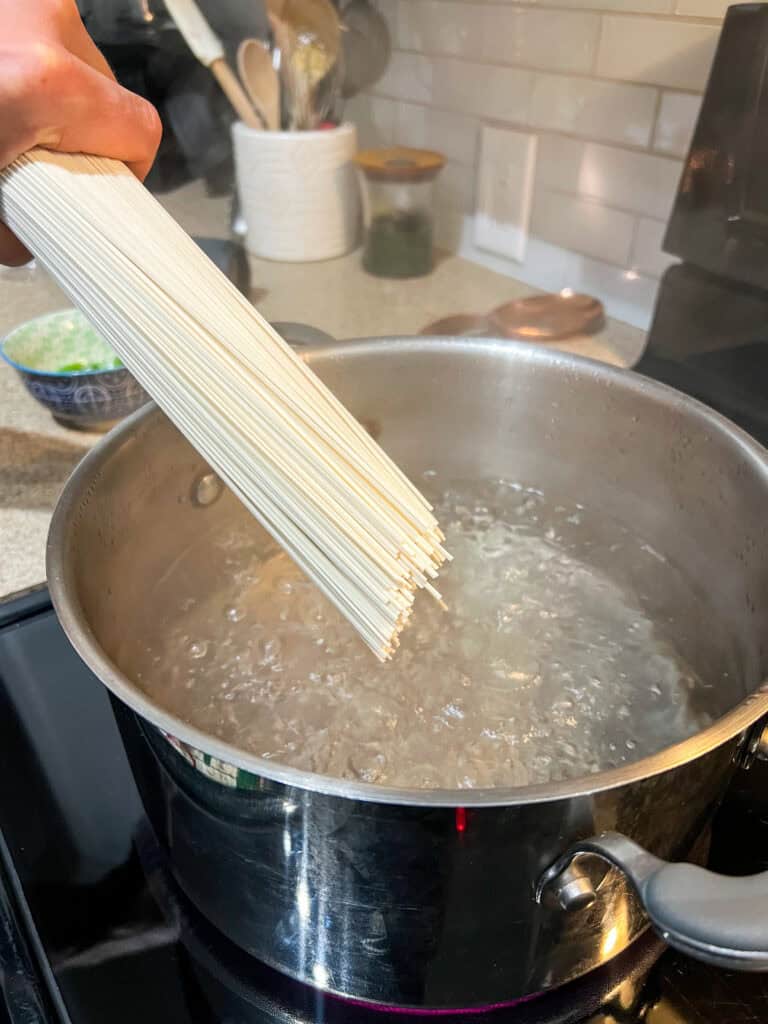
- Prep the Veggies: Chop mushrooms, cabbage, and green onions into bite-sized pieces.
- Cook the Vegetables: Heat a little vegetable oil in a large skillet over medium-high heat. Add green onion bottoms, mushrooms, cabbage, and edamame. Stir-fry for 3-5 minutes until softened.
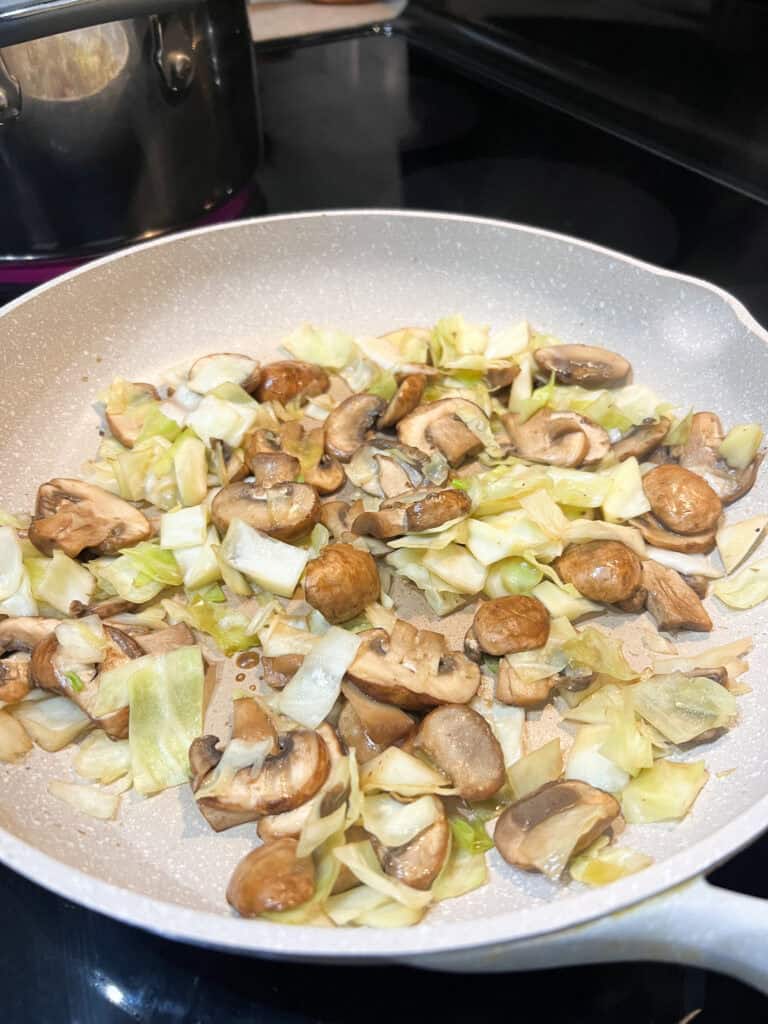
- Make the Sauce: In a small bowl, whisk together gochujang paste, low-sodium soy sauce, tahini, lime juice, miso paste, brown sugar, and garlic powder. Add water to thin if necessary.
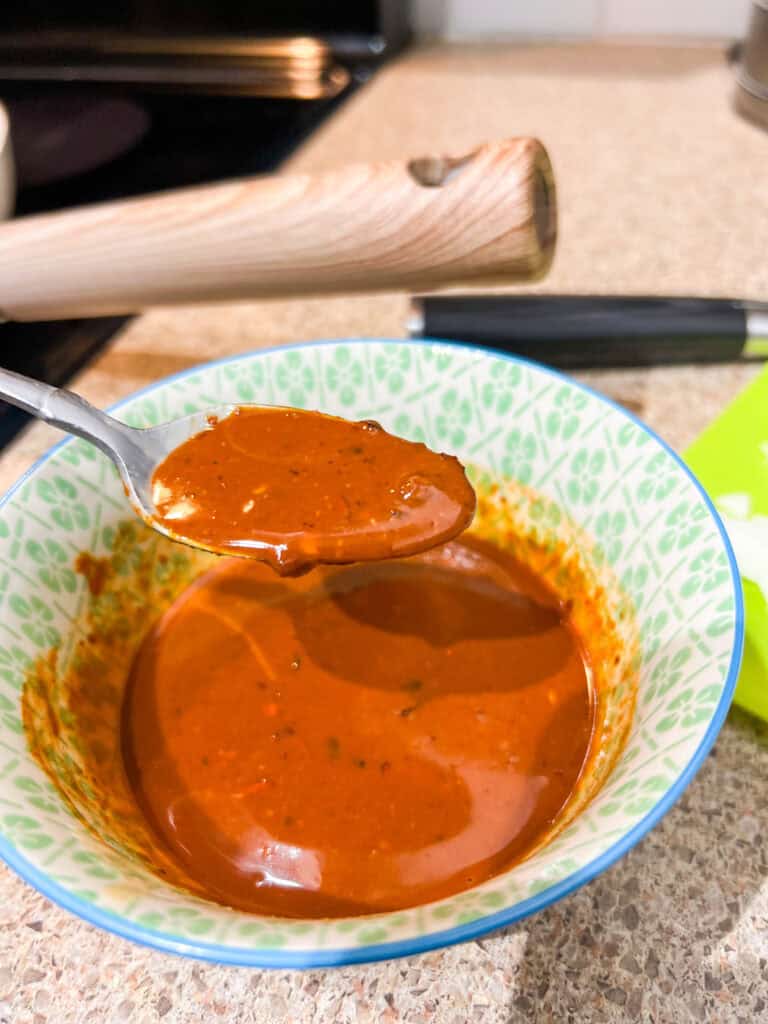
- Combine Everything: Toss the cooked noodles and sauce into the skillet with the veggies. Cook for 1-2 minutes, stirring to combine.

- Serve: Garnish with green onion tops, sesame seeds, and chili oil.
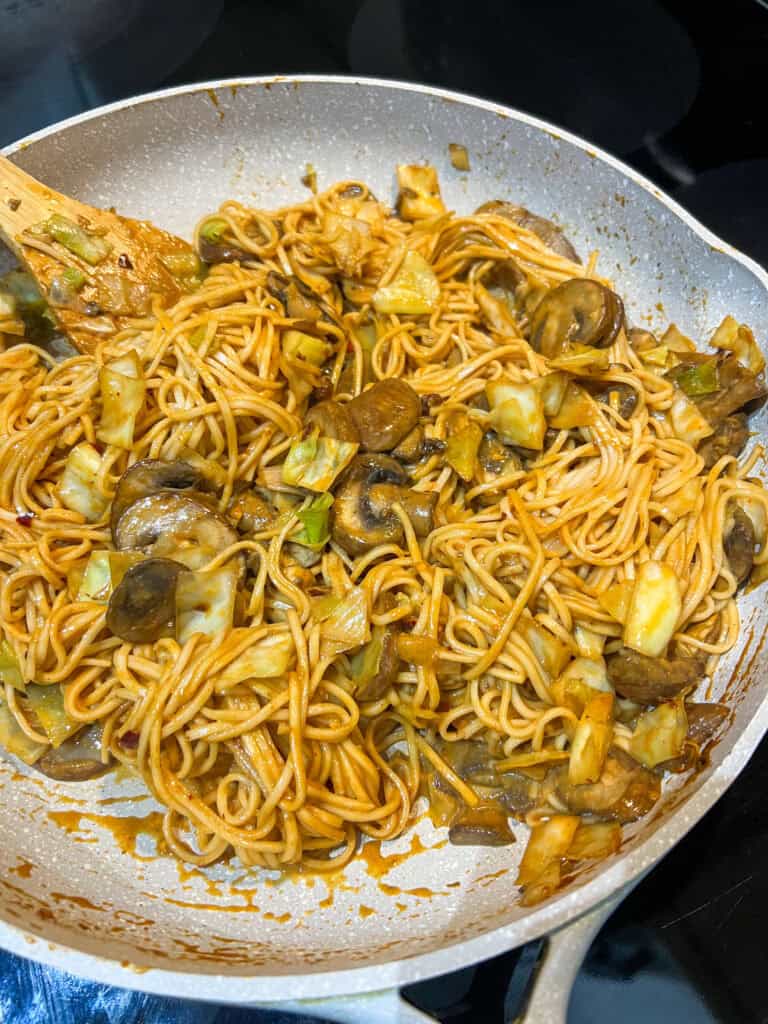
- And enjoy these saucy gochujang noodles warm!
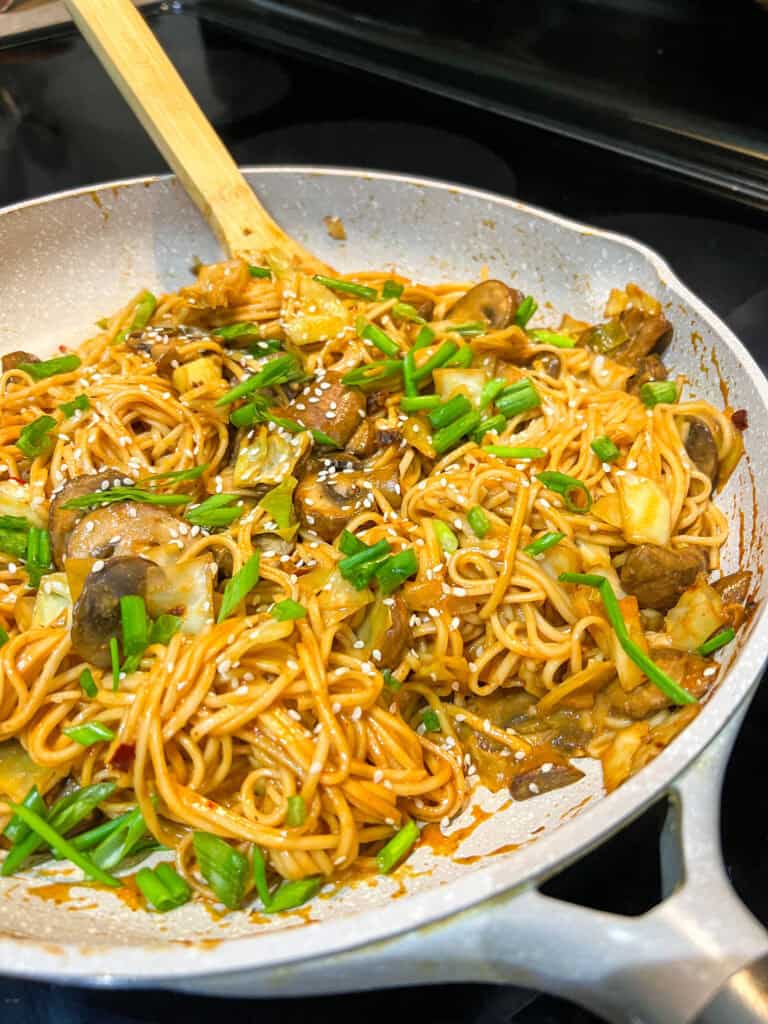
Tips & Tricks for Perfect Gochujang Noodles
- Adjust the Spice Level: Add more or less gochujang paste to suit your taste.
- Use Fresh Ingredients: Fresh veggies and high-quality gochujang paste make all the difference.
- Don’t Overcook the Noodles: Aim for al dente for the best texture.
- Experiment with Proteins: Add tofu, tempeh, or even ground vegan meat to make it heartier.
FAQs
Ramen noodles, rice noodles, or even zucchini noodles work well in this recipe.
Yes! Store leftovers in an airtight container in the fridge for up to 3 days.
Look for it at your local Asian market or in the international aisle of grocery stores.
Absolutely! Use less gochujang paste and add extra lime juice or tahini to mellow the heat.
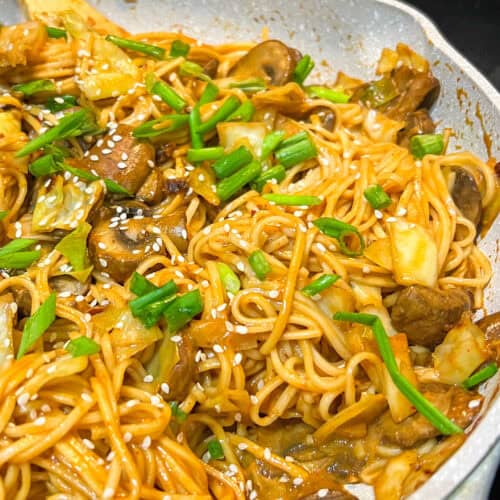
Easy Gochujang Noodles Recipe
Ingredients
- 400 grams ramen noodles or wide rice noodles for GF
- 1 cup edamame beans optional. See notes for protein options
- 4 green onions, diced
- 3-4 cups vegetables of choice I used mushrooms and cabbage
Creamy Gochujang Sauce
- 3 tbsp Gochujang sauce
- 2 tbsp low-sodium soy sauce tamari for GF
- 3 tbsp tahini
- 2 tbsp lime juice
- 2 tsp miso paste optional
- 1 tbsp brown sugar or maple syrup
- 1 tsp garlic powder or used 2-3 cloves fresh
- water to loosen
Toppings
- diced green onion tops
- sesame seeds
- chili oil
Instructions
- Boil the noodles according to package instructions.
- Chop up the veggies into bite-sized peices.
- In a pan on medium heat add a little oil, the bottoms of the green onions, vegetables, and edamame if adding. Cook for 3-5 minutes stirring occasionally. Make sure the mushrooms and edamame are cooked through.
- Next, make the sauce by combing soy sauce, Gochujang, brown sugar, tahini, garlic powder, lime juice, and miso and whisking until smooth. Add a tablespoon or two of water if needed to thin it out.
- Add the cooked noodles and sauce into the same pan the vegetables are cooking in, and cook for another minute or two until all ingredients are combined. Add a little water if needed to loosen the sauce but careful not to add too much.
- Sprinkle on your favourite toppings, serve and enjoy!
Notes
Nutrition
Conclusion: Gochujang Noodles Recipe
These vegan gochujang noodles are a vibrant, flavorful dish that’s easy to prepare and endlessly customizable. Whether you’re craving spicy Korean noodles or looking for a quick weeknight meal, this recipe delivers big on flavor and simplicity. Pair it with gyoza or spring rolls for a takeout-inspired feast right at home!

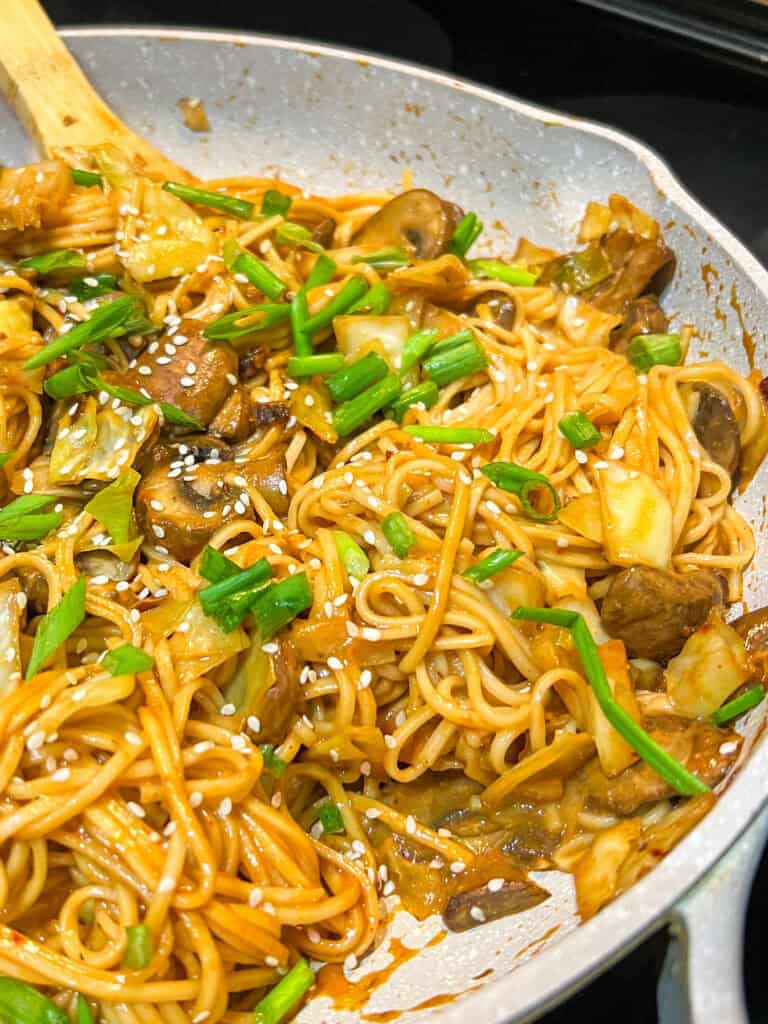
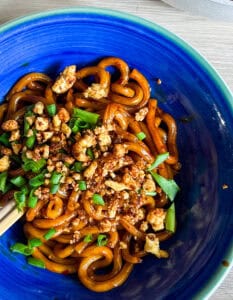
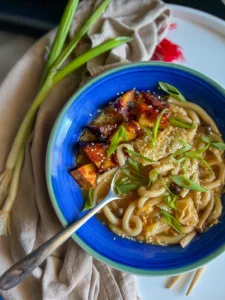
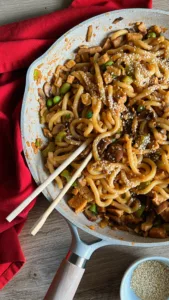
Wow this noodle recipe was so quick
And easy, loved the flavour I doubled the sauce as I like my dishes a little more saucy. But was super easy to follow and hit the spot.
Thanks so much for trying out the recipe Allison! So happy you found it quick and easy, it’s one of my go to recipes for a busy week 😀
Can you please post more plant based noodle recipes that are quick to make like this? Loved this one and always looking for more. You have fantastic recipes by the way and patiently waiting for your cook book 😉
You just made my whole week!!! Thank you SO much! One day I will come out with a cook book for sure! and yes i’ll keep coming out with more easy noodle recipes! I loveee these types of dinners!